- What is salary benchmarking?
- Why is salary benchmarking important?
- Different methods of salary benchmarking
- Manual salary benchmarking (aka salary surveys)
- How to do automated salary benchmarking (aka Ravio)
- Can you use both salary surveys and compensation benchmarking software together?
- FAQs on salary benchmarking
Salary benchmarking is a vital part of any organisation’s compensation strategy. It helps People and Reward teams, HR professionals, and business leaders determine competitive pay by analysing market rates based on location, role, industry, and level.
Beyond setting salaries, salary benchmarking underpins critical aspects of compensation management. With accurate benchmarking data, teams can build salary bands, target specific market percentiles, and ensure compliance with regulations like the EU Pay Transparency Directive.
There are two main ways to access salary benchmarks: traditional salary surveys (like those from Radford or Mercer) or modern salary benchmarking tools like Ravio. While salary surveys require a highly manual process and often provide outdated data, real-time tools offer a faster, more accurate view of the market, enabling a better comparison between external benchmarks and internal salary data.
Whatever process you choose, one thing remains the same: without reliable salary benchmarks, companies risk underpaying employees and losing talent, or overpaying employees and struggling to control budgets and scale sustainably.
In this guide, we’ll cover everything you need to know about salary benchmarking, including:
- What is salary benchmarking?
- Why is salary benchmarking important?
- Different methods of salary benchmarking (manual vs. automated approaches)
- Can you use both salary surveys and compensation benchmarking software together?
- Example: What does a salary benchmark look like in practice?
Subscribe to our newsletter for monthly insights from Ravio's compensation dataset and network of Rewards experts 📩
What is salary benchmarking?
Salary benchmarking is the process of comparing employee pay to the broader market to ensure fair and competitive compensation. The goal is to align what you pay your employees with what the market pays, which involves analysing salary data for similar roles, job levels, and industries, filtered by factors such as location and company size.
Depending on your compensation philosophy, this might be simply aligning with the market and targeting the 50th percentile, or leading the market and targeting the 75th percentile. Regardless of where on the benchmarking scale you want to pay, benchmarking is critical for bringing your strategy to life and enabling your organisation to attract and retain top talent.
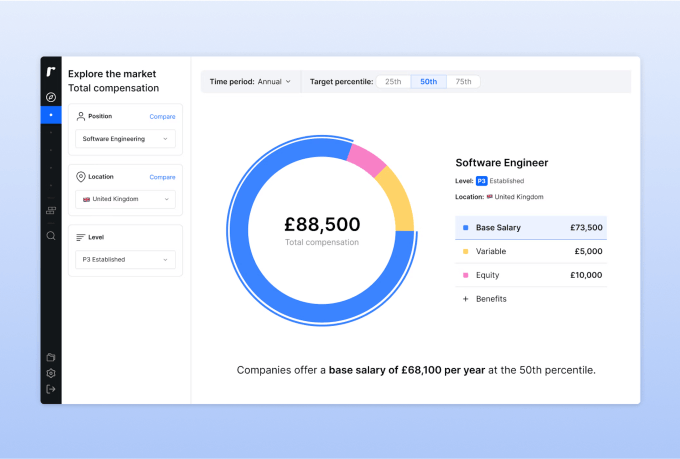
With salary benchmark data, People and HR teams can build salary band structures tailored to roles, locations, and levels. They can also calculate key percentiles such as the 25th, 50th (median), and 75th percentiles and ensure pay equity by aligning employees salaries with fair market rates.
💡 What’s the difference between the 25th, 50th, and 75th percentiles?
Percentiles relate to the distribution of market salaries for a given role. For instance, a salary at the 50th percentile means that 50% of salaries paid by other companies are below this value, and 50% are above – making it the market median salary.
Companies typically determine a target percentile as part of their compensation philosophy, shaping how they pay employees compared to the wider market:
- 50th percentile (meeting the market): Aligns employee pay with the market standard, offering competitive salaries that are in line with most companies.
- 75th percentile (leading the market): Pays at the higher end of the market, offering very competitive salaries to attract and retain top talent.
- 25th percentile (lagging the market): Offers salaries below market standard, which may align with companies prioritising other benefits or cost-efficiency strategies.
Including percentile targets within your salary benchmarking strategy helps ensure compensation decisions align with your overarching business goals.
Why is salary benchmarking important?
Salary benchmarking isn’t just a nice-to-have – it’s a necessity for companies looking to remain competitive in today’s market.
Without accurate benchmarks, organisations risk underpaying employees, leading to attrition and reputational damage, or overpaying, which can inflate costs and strain budgets.
Here’s why it’s a must-have for every business.
1. Benchmarking helps you retain talent
Dissatisfaction with pay consistently ranks as the number one reason employees leave their jobs. If your company doesn’t pay employees at or above their market value, they’re likely to seek better opportunities elsewhere – often with your competitors.
In fact, according to Ravio’s Compensation Trends report, 61% of companies cite cash compensation as the main challenge to retaining talent.
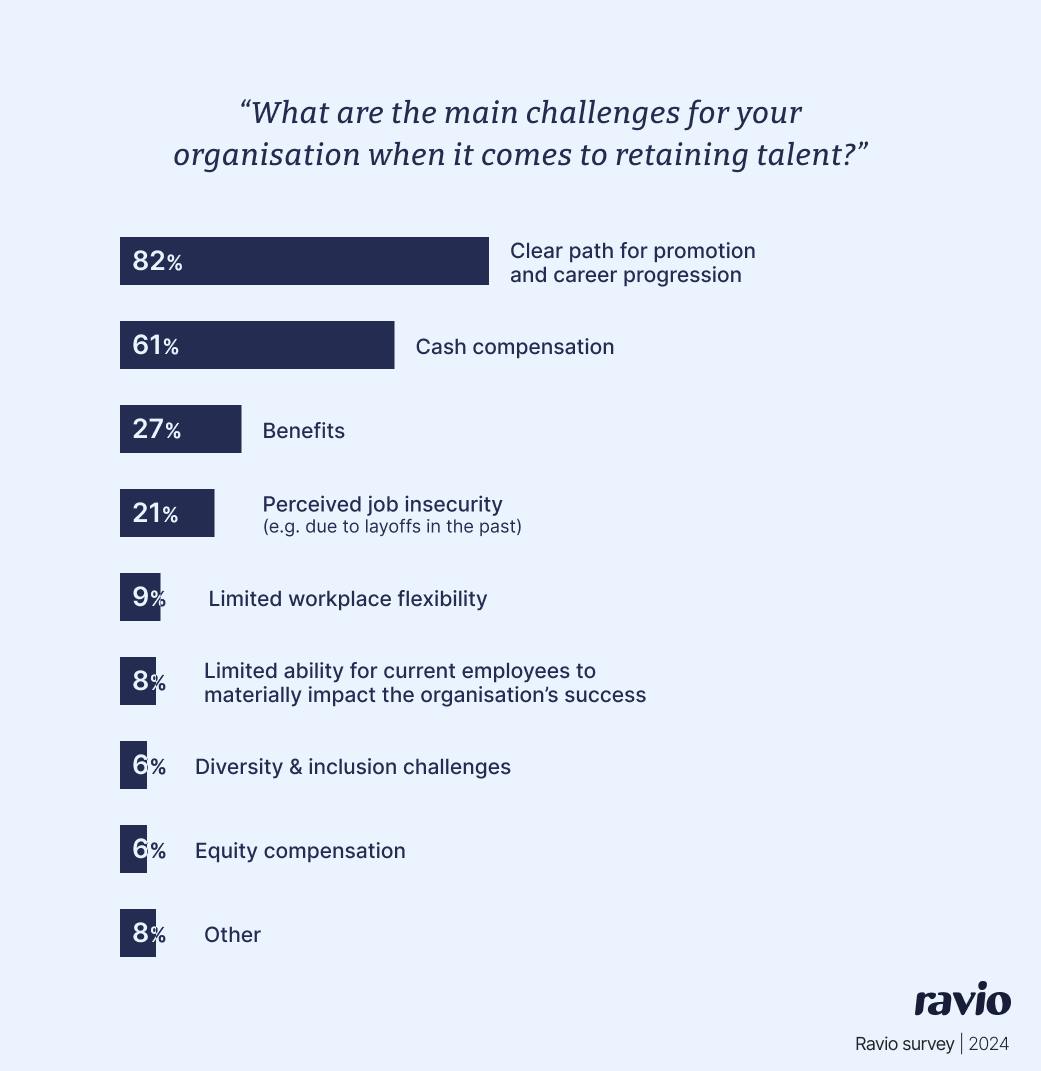
However, maintaining competitive salaries isn’t always straightforward.
Budgets, economic conditions, and talent market shifts can quickly render old benchmarks obsolete. Companies that don’t revisit benchmarks regularly may struggle to stay within desired percentiles, like the 50th or 75th.
This is where salary benchmarking becomes critical.
It gives you a clear, data-driven understanding of what competitive compensation looks like for roles across your organisation.
Think of it as a market compass, showing you how similar companies compensate employees in comparable positions, helping you to foster loyalty and retention amongst your employees.
Hiring top talent is typically a business priority, as is employee retention – especially due to the high costs of replacing a great employee. For this reason, this is usually the most important argument to highlight to senior leadership decision-makers when making the case to get budget for reliable salary benchmarking data.
2. Benchmarking lowers your attrition costs
Replacing an employee is far more costly than most organisations realise. The total cost of attrition, including recruitment, onboarding, and lost productivity, typically amounts to 6-9 months of the employee’s annual salary. For specialised or senior roles, these costs can escalate even further.
By using salary benchmarking to align employee compensation with market rates, you can reduce turnover and minimise the financial impact of attrition.
💰The cost of attrition
Let’s say your company employs a P3 Software Engineer in London who earns £66,700 at the market median (50th percentile).
If software engineers make up 25% of your workforce in a 500-person organisation with a 5% attrition rate, you could lose over £600,000 annually just replacing software engineers. And that’s before accounting for other roles across your business!
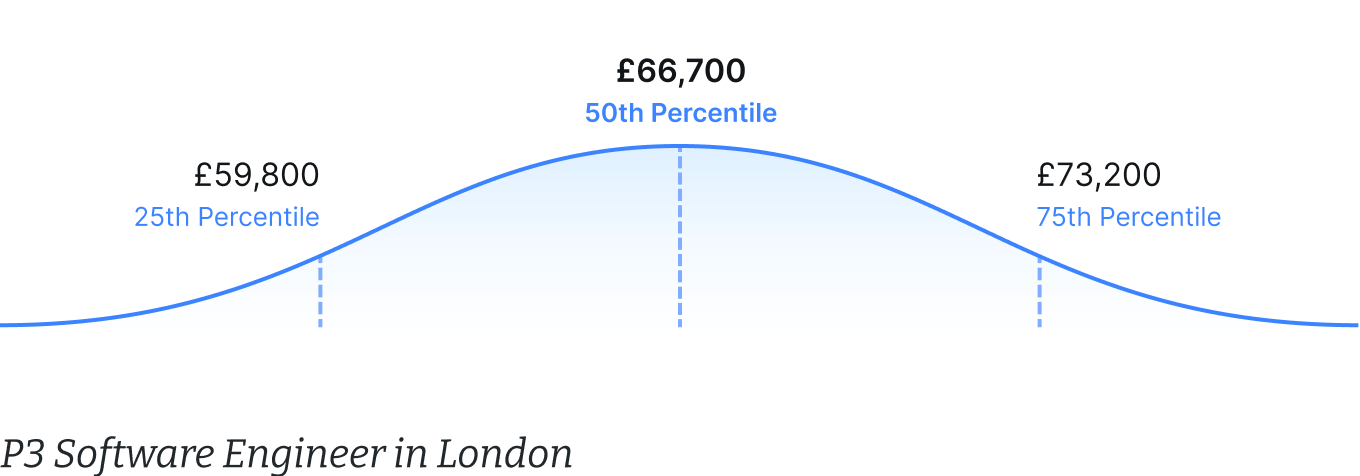
3. Benchmarking avoids overpaying employees
While underpaying employees can lead to attrition, overpaying comes with its own set of challenges – particularly for businesses with tight margins or ambitious growth plans. Without accurate salary benchmarks, it’s easy to overspend on payroll, which often makes up around 70% of total operating expenses.
Salary benchmarking provides a data-driven framework for managing payroll costs effectively. By aligning salaries with market rates and targeting specific percentiles, you can strike a balance between offering competitive pay and maintaining financial sustainability – something that is particularly important for tech companies, where people costs represent the largest line item on the P&L.
💰 ROI in action: How accurate benchmarks can save US companies $140,000 when building an Engineering hub in London
Scenario: A US tech company is opening its first London office – hiring 10 P3 Software Engineers. Without accurate, market-specific benchmarks, they might rely on US salary data, risking significant overpayment.
The numbers: Using a US-focused salary benchmark, they set salaries at $150k USD per engineer, leading to an annual payroll cost of $1,050,000 USD.
In comparison, the correct London market benchmark for a P3 Engineer is £71,000 GBP ($91,000 USD), which reduces the annual payroll cost to $910,000 USD.
The saving: By aligning salaries to the local market, the company saves $140,000 USD (£103,710 GBP) annually – demonstrating how accurate benchmarking prevents overspending while still maintaining competitive pay.
4. Benchmarking ensures compliance with pay equity legislation
Pay transparency is no longer just a competitive advantage – it’s becoming a legal requirement.
The upcoming EU Pay Transparency Directive, set to take effect in 2026, will make compliance with pay equity legislation mandatory for all employers with European-based employees.
Salary benchmarking will be instrumental in meeting these requirements and ensuring fair pay practices. By providing an objective foundation for pay decisions, benchmarking data removes guesswork and risk of bias – often strong influencers on compensation decisions – and ensures salaries are determined in line with the market rather than subjective judgments.
Different methods of salary benchmarking
There are several methods for salary benchmarking, but they vary widely in reliability due to differences in data sources and accuracy.
According to Ravio's survey results in 2024, the majority (68%) rely on real-time providers like Ravio when determining pay for new hires, while a surprising 60% also rely on candidate salaries.

Ultimately, only two methods are considered consistently reliable: manual benchmarking and automated benchmarking. Each has its own advantages and challenges, and the choice depends on your organisation's specific needs, resources, and goals.
- Manual salary benchmarking: Relies on spreadsheets and salary surveys from providers like Radford (part of AON), Mercer, or WTW. It involves manually collecting and analysing data from complex spreadsheets, which is often outdated by the time you can access it.
- Automated salary benchmarking: Uses modern tools like Ravio to access reliable, real-time market data directly through a platform. This eliminates manual work and makes comparing internal salary data to external benchmarks a simple task.

Let's take a closer look at how to do salary benchmarking through different methods.
Manual salary benchmarking (aka salary surveys)
Manual salary benchmarking has traditionally relied on salary surveys from providers like Radford, Mercer, and Willis Towers Watson (WTW).
These surveys collect and aggregate compensation data from various organisations, including information on base salaries, bonuses, equity, and employee benefits.
The process is lengthy and resource-intensive. It begins with companies submitting detailed employee compensation data, which is then compiled and sold as benchmarking datasets. These can be purchased as full datasets that cover all participating companies or as custom peer-group reports tailored to specific locations or industries (often at an additional cost).
While salary surveys provide comprehensive data, they come with significant challenges. The manual nature of the process means:
- Outdated insights: Data can be months old by the time it’s delivered.
- Time-intensive efforts: HR teams must manually align internal roles with the provider’s frameworks and interpret static spreadsheets.
- Broad datasets: Often, the data is too general, making it less relevant for startups or companies in niche industries.
💡 Deadlines for submitting data to salary survey providers
It’s worth noting that these survey providers follow a strict survey cycle, and so companies normally need to submit all their data in one go between April and May.
Data will be gathered in May, analysed, and then benchmarks are released later in the year, around September.
Often, the salary benchmarks released later are the benchmarks for that year. That means the data is nearly 6 months out of date by the time it is received, and will be 18 months out of date by the time the data is received for the following year.
Here’s a step-by-step on how to salary benchmarking through using salary survey providers:
Step 1: Define your compensation philosophy
Before starting the salary benchmarking process, it’s essential to establish a clear compensation philosophy. This philosophy acts as the foundation for all benchmarking activities, ensuring consistency in how your company sets salaries and communicates its approach to pay. A well-defined philosophy provides direction and builds trust with employees and stakeholders.
Here’s what your compensation philosophy should address:
- Target percentiles: Decide where you want to position your company in the market. Will you pay at the 50th percentile (market median), the 75th percentile for critical talent, or another target to align with hiring and retention goals?
- Equity and bonuses: Determine whether equity or variable pay will be part of your compensation structure, and decide how these elements will be distributed across different levels or roles.
- Pay for performance: Decide if and how performance will influence salary increases or other rewards like bonuses.
- Pay transparency: Consider how transparent you want to be with your compensation approach, ensuring alignment with legal requirements (e.g., salary range disclosures) and company values.
💡 Ravio tip: establish your compensation philosophy as early as possible
A clear compensation philosophy gets everyone on the same page, providing clarity to employees and stakeholders alike. It helps you explain decisions, like why certain roles are targeted at the 75th percentile, or why equity is reserved for specific roles.
As your company scales, you’ll need to answer increasingly detailed questions from leadership, board members, and employees about your approach to pay. Building a strong foundation early saves time and ensures consistency as your organisation grows.
Step 2: Update your job architecture
Accurate salary benchmarking starts with a clear and standardised job architecture. This framework ensures that your internal job titles and descriptions align with the market, making it easier to compare roles against benchmarking data. A good rule of thumb is to compare employees to job descriptions that have an 80% match, according to the Economic Research Institute.
Here’s how to update your job architecture effectively:
- Group similar roles to reduce complexity (for example, instead of unique titles for each employee, standardise levels like “Software Engineer P3”).
- Align roles with market data by ensuring at least an 80% match in responsibilities and skills.
- Use scalable role structures to support growth (e.g., define broad categories now and refine as your company expands).
This step is critical for accurate job comparisons during the benchmarking process. However, when using a traditional compensation method like salary survey providers, this can be a laborious process.
“No one experiences any joy doing a salary benchmarking exercise for a 500 person organisation that has 500 unique job titles. The overriding principles when creating or updating your job architecture are to eliminate ambiguity - people should be able to understand someone’s role just from their title - and to build for scale, you want your job architecture to grow with you.”

Chief People Officer, Ravio
Step 3: Identify your relevant peer groups
Determine which companies you want to benchmark against. This ensures your salary data reflects your talent competitors and is relevant to your industry and growth stage. Consider factors like:
- Industry: Benchmark against companies in the same field (e.g. SaaS vs. manufacturing will likely alter the benchmarking data you see significantly).
- Geography: Compare roles within the same location to account for cost-of-living differences.
- Company size: Use data from organisations with similar headcounts or funding stages. There’s no point comparing a 50-person company with a 5000-person enterprise!
If you are using a typical salary survey provider, you’ll likely need to complete their global grading system – a framework that evaluates your company based on key metrics such as employee count, revenue, and organisational complexity. This system assigns your organisation a grade, aligning it with similar companies for benchmarking purposes. This process can be time-consuming and inflexible, often relying on outdated tools and methodologies.
“[Before Ravio] it was very difficult for us to compare ourselves with the right sectors, organisations, and competitors as we are a tech scale-up. We have so many developer positions – like different engineering types and product roles – so we needed data for tech scale-ups, versus large corporate organisations.”

Head of People & Culture, Tiqets
Step 5: Map roles to salary survey data
Mapping your internal job roles and levels to a benchmarking dataset is a crucial yet complex step in the salary benchmarking process. Salary surveys use predefined job frameworks that include hundreds of roles and levels, often differing significantly from your company’s structure.
For instance, roles like “Software Engineer P3” in your organisation may not align perfectly with the frameworks in salary surveys, leading to challenges in finding accurate comparisons. These discrepancies can cause inconsistencies in how roles are interpreted by survey participants and ultimately lead to inaccurate benchmarks.
To address these challenges:
- Understand the predefined frameworks: Familiarise yourself with the job families, roles, and levels outlined by the salary survey provider.
- Identify the closest match: Aim to map roles that have at least an 80% overlap in responsibilities and skills with the predefined benchmarks.
- Document and standardise your approach: Keep a consistent methodology for mapping to minimise errors and ensure reliability.
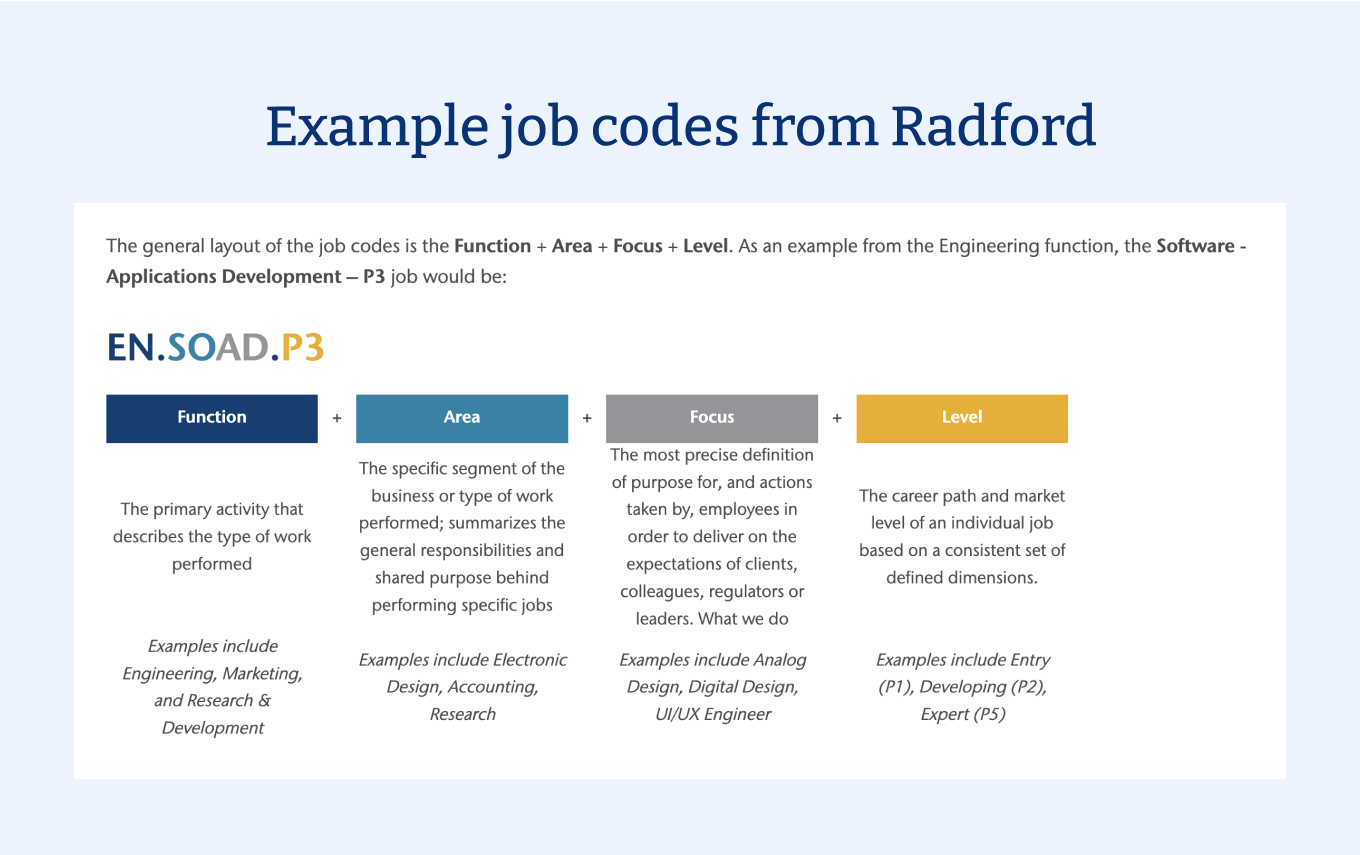
Step 6: Calculate your target market percentiles
Calculating market percentiles is a key step in salary benchmarking, as it provides the foundation for making informed compensation decisions. Percentiles represent the distribution of salaries in the market, helping you identify where your company wants to position itself in relation to competitors.
Here are the key metrics to focus on:
- 25th Percentile: Reflects entry-level pay for the role, suitable for cost-conscious organisations or those targeting junior talent.
- 50th Percentile (Median): Represents the midpoint of the market, where half of companies pay less and half pay more. Often used as a baseline for competitive pay.
- 75th Percentile: Reflects premium pay rates designed to attract top-tier talent or for high-demand roles.
When choosing your target percentile, consider your compensation philosophy, hiring goals, and budget constraints. Aligning with the right percentile ensures your salaries are competitive while remaining sustainable.
Step 7: Build salary bands
Once you have calculated market percentiles, the next step is to create salary bands. Salary bands provide structured pay ranges for roles based on market data and internal compensation philosophy, helping you balance competitiveness and cost control.
Here’s how to approach salary band creation:
- Start with the target percentile: Use your chosen percentile (e.g., 50th percentile) as the midpoint for each band.
- Set range spreads: Define upper and lower limits around the midpoint, considering factors like job level, experience, and tenure. For example, a common range might span 80%-120% of the midpoint.
- Group roles into bands: Organise roles into departments, job families, or functions, ensuring similar positions are grouped within the same band for consistency.
Building salary bands using traditional salary survey providers often involves working with large, complex spreadsheets, which can be time-consuming, require advanced Excel skills, and can lead to errors when interpreting data or aligning roles. Not only that, but People and HR teams must also calculate ranges and adjust for market changes – making it a challenging and frustrating task.
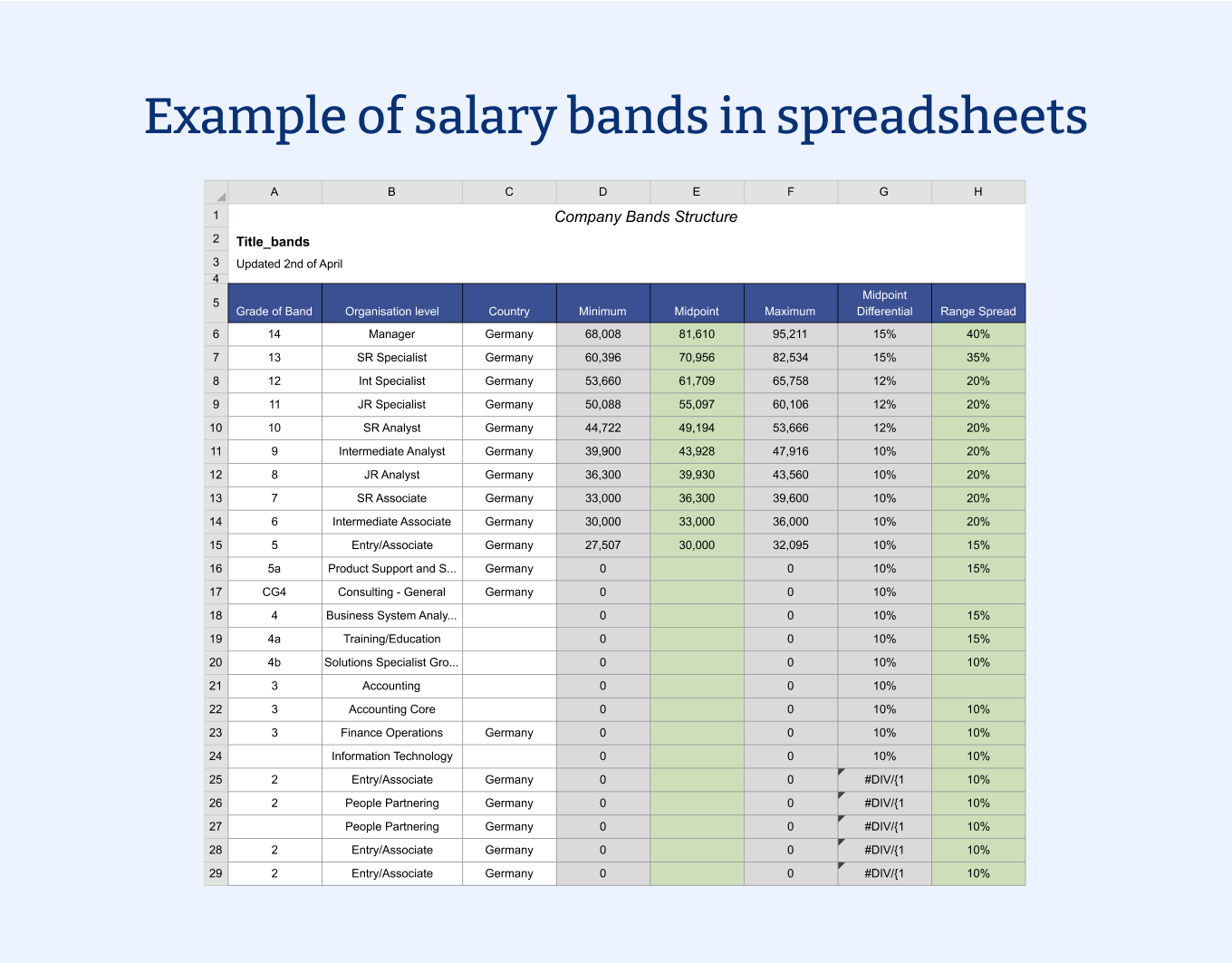
How to do automated salary benchmarking (aka Ravio)
Now you know all the steps to do salary benchmarking through traditional providers like Radford or Mercer, you’ll be glad to know that there are much simpler alternatives.
Automated salary benchmarking offers a simpler and more efficient alternative to traditional methods like salary surveys. Compensation software platforms, such as Ravio, streamline the entire process, eliminating the need for manual data collection and interpretation.
It works by pulling compensation data directly from your HRIS and automating the process of data collection. They also automatically map your job roles and levels to standardised frameworks, ensuring consistent, reliable comparisons.
Let’s look at a step-by-step of how to do salary benchmarking with Ravio.
Step 1: Connect your HRIS to Ravio
Ravio integrates with over 100 HR tools, enabling real-time benchmarking across its database of 1,000+ companies. Unlike traditional salary surveys, where data becomes outdated by the time it’s delivered, Ravio provides live market data to ensure you’re always working with the most accurate benchmarks.
“Access to Ravio’s live market data means no more headaches from delayed data sets or having to age compensation data, which has been a real friction point for us in the past. Ravio offers real-time data with amazing visualisations making it the easiest and most user-friendly benchmarking tool we use.”

VP People, Mollie
💡We have detailed integration guides that will help walk you through the process, plus we’re SOC-II and GDPR compliant.
Step 2: Map to Ravio’s job levelling framework
One of the most time-consuming aspects of manual salary benchmarking is leveling employees to align with benchmarking frameworks. Traditional methods require you to manually map roles, which can take days or even weeks, especially for large teams or companies with unique job structures.
With Ravio, you can map your employees to our job leveling framework or integrate your existing framework using a correlation table. It typically takes just a few working days to complete, and is of course, free!
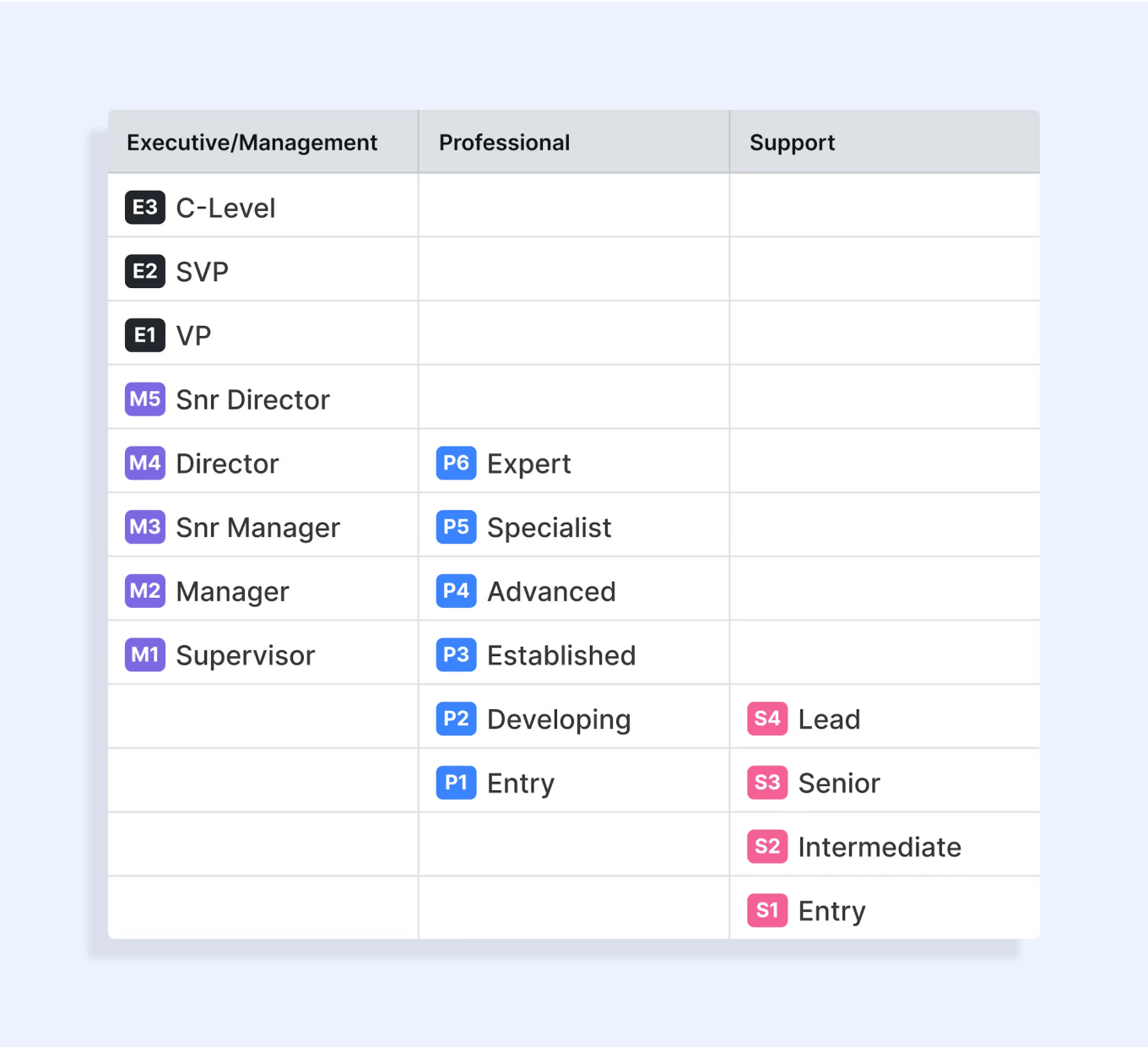
💡 Why does Ravio handle levelling for you?
There are a few reasons why Ravio handles this step for you:
- Saves time: Manual levelling is complex and resource-intensive. Ravio’s automated process gives your team valuable time back to focus on strategic priorities.
- Ensures consistency: When companies handle their own leveling, inconsistencies often arise due to varied interpretations of job roles. Ravio standardises this process, ensuring accurate and consistent comparisons against relevant market benchmarks.
For more information on Ravio's levelling process, read our guide.
And that’s it, no further work is required...genuinely!
When we accessed Ravio’s data, we quickly realised the benchmarks were much more realistic and reliable. Ravio also made sure the benchmarks and settings reflected the right company size and funding stage relevant to Sastrify.

Sastrify
Once a Ravio customer connects their HRIS, and levelling is done, People & Reward teams can use all of Ravio’s functionality. This includes:
Salary benchmarks
Whether hiring for a new role, running a compensation review, or checking a benchmark for a current employee – you can use automated salary benchmarking tools like Ravio to filter by different roles, levels, geographies, funding stages, industries, and company sizes.

Salary bands
Building and refreshing bands manually can be very painful. The formulae are complex, the spreadsheets are vast, and it’s really difficult to analyse the data to draw out useful information. With automated salary benchmarking tools, you can build salary bands with ease and model different bands scenarios to understand how to stay within budget whilst achieving people objectives.
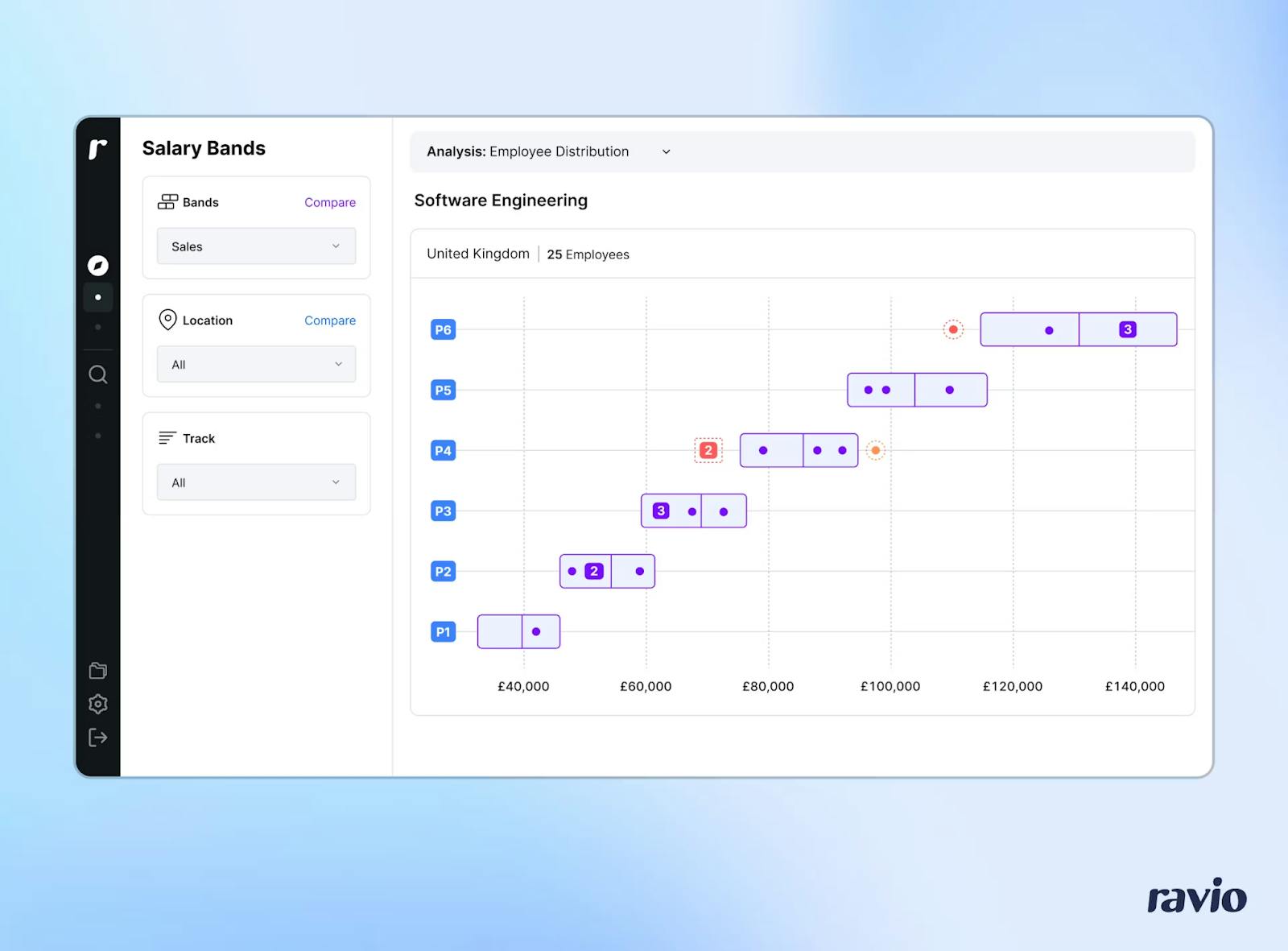
Pay equity
Once your salary bands are established, analysing internal pay equity becomes significantly more straightforward. Automated tools like Ravio provide detailed insights into employee compensation, helping you identify outliers who fall outside their salary band or roles that lag behind market benchmarks.
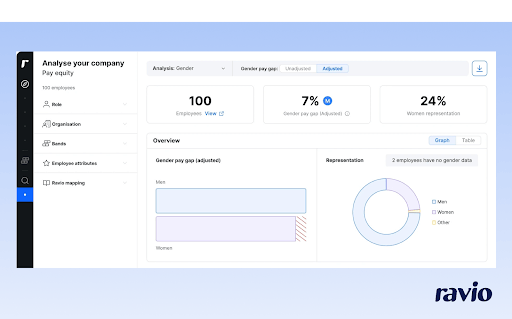
These insights can also extend to analysing broader equity concerns, such as assessing the gender pay gap across different functions, levels, or roles.
By leveraging these insights, People and Reward teams can address disparities proactively, ensuring that compensation decisions align with both market trends and internal fairness. This process not only builds trust with employees but also ensures compliance with emerging pay transparency regulations, like the EU Pay Transparency Directive, which mandates reporting and action plans for significant gender pay gaps.
💡What about Glassdoor or LinkedIn?
The other alternative data source that some companies use for salary benchmarking is desk research: finding anonymous employee-reported salary data from company review sites like Glassdoor, or from the salary range listed in job adverts on sites like LinkedIn or Indeed.
They’re free and easy to access which makes them appealing, but these are both highly inaccurate sources of data.
In the case of Glassdoor, the data is unverified, crowdsourced from users of the website with no checks to ensure that the user is submitting accurate data.
There’s typically a huge amount of variance in the salaries submitted and the salary range shown to you simply represents the average of all salaries ever submitted for that role: it doesn’t account for outliers or identify up-to-date shifts in the salary based on market trends.
Here’s an example of a Senior Software Engineer salary range from Glassdoor’s salary calculator to illustrate this point – there’s no descriptive information to anchor their definition of ‘senior software engineer’ on (aside from the 1-3 years of experience, which is confusing in itself for a ‘senior’ role), and the salary range is too broad to be useful.
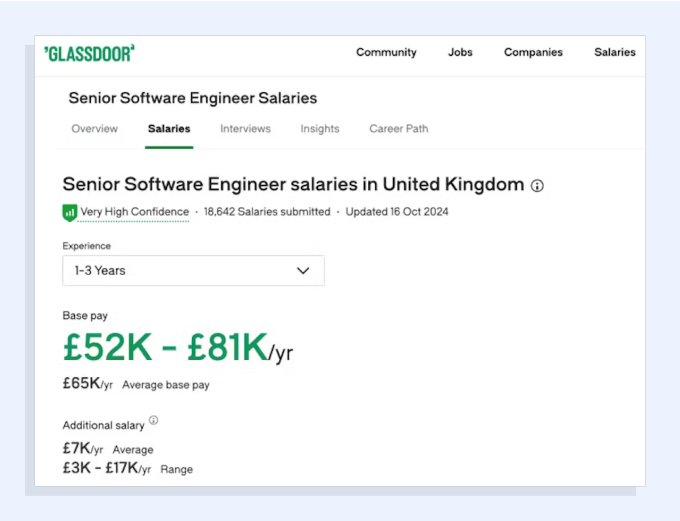
Can you use both salary surveys and compensation benchmarking software together?
Salary surveys and compensation benchmarking software don’t have to be mutually exclusive solutions. In fact, many companies find value in combining both to achieve a more comprehensive approach to salary benchmarking.
By leveraging the strengths of each method, organisations can ensure broader coverage and increased confidence in their compensation strategies.
Here are the scenarios where combining both solutions is particularly useful:
- Large-scale or complex organisations: Established scale-ups or public companies with a large headcount and geographically dispersed teams often benefit from multiple data sources. Salary survey providers like Radford or Mercer may have deeper datasets for specific locations or roles, while tools like Ravio offer real-time, peer-group-specific data for more dynamic insights. Combining both ensures full coverage of a diverse workforce.
- Niche roles or industries: Companies heavily reliant on niche roles – such as biotech specialists or AI researchers – often face limited benchmarking data. Traditional salary surveys may offer specialised datasets for these roles, while compensation software provides real-time data for broader market trends. Using both allows organisations to cross-reference insights and validate benchmarks.
- Enhanced compensation management features: Modern benchmarking software goes beyond just providing salary data. Tools like Ravio include additional features like salary band creation, pay equity analysis, and compensation review planning. Combining these functionalities with the broader datasets of salary surveys ensures companies can both access reliable benchmarks and implement them effectively across their organisation.
Example: What does a salary benchmark look like in practice?
Let’s say your company is hiring for two roles: a P3 Software Engineer in London and a P2 Software Engineer in Poland. Both are individual contributor roles (“Professional” level), but the P3 position is more senior, and London’s higher cost of living makes its market benchmark significantly higher than Poland’s.
With a traditional salary survey provider, you’d start by submitting your company’s data. After weeks of waiting, you’d receive a dataset that’s months old. You’d then need to manually align your job roles with the provider’s job codes and interpret static benchmarks.
However, if you used a compensation software provider, you could easily access live market benchmarks tailored to your company’s specific peer group, filtered by location, industry, and company size.
You’d see that the 50th percentile for a P3 Software Engineer in London is £66,700 while a P2 Software Engineer in Poland is significantly lower at £43,000.
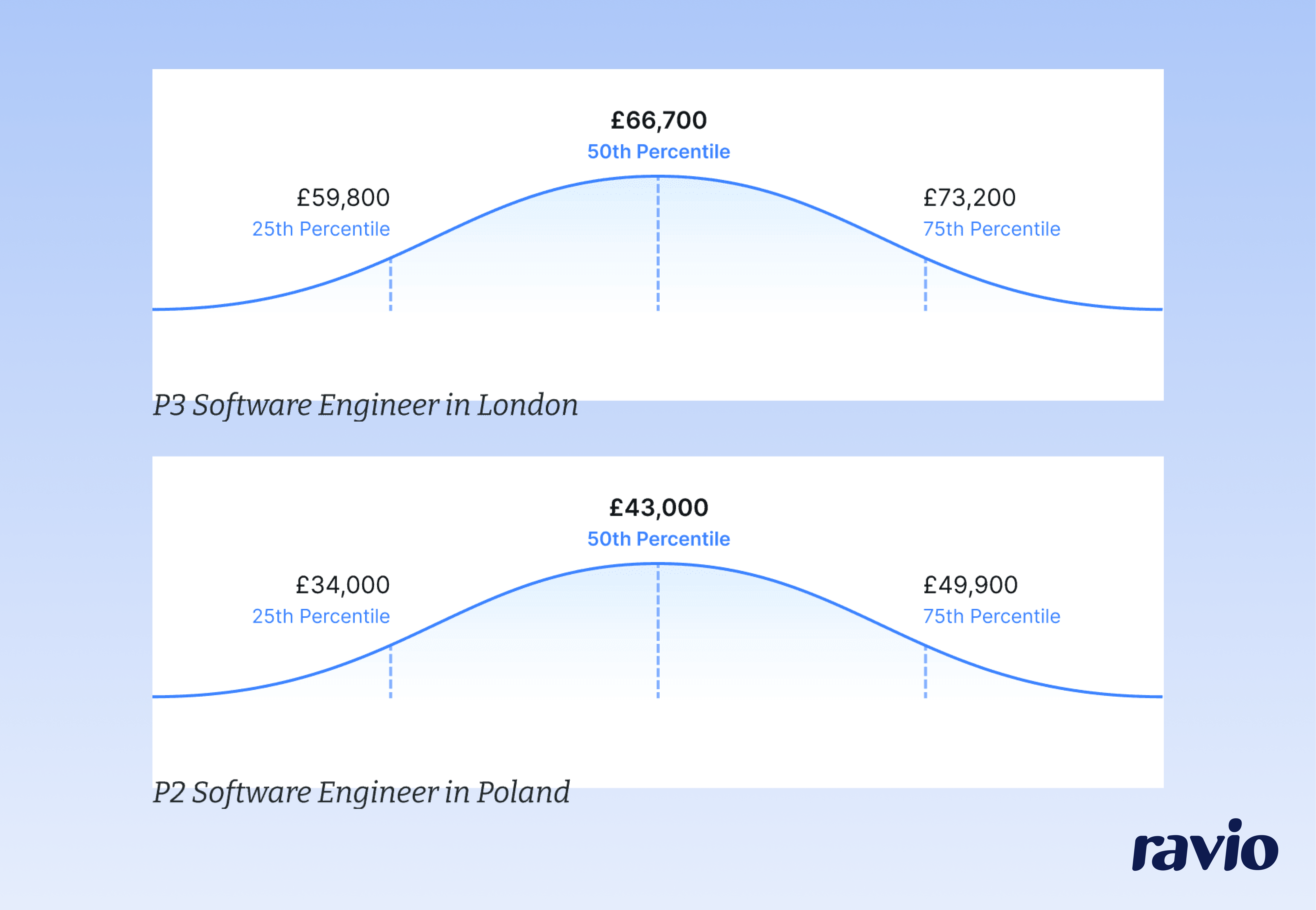
This example highlights why benchmarking by job level, location, and function is so critical. It ensures your offers are competitive and fair, tailored to the nuances of each role and geography.
Accurate salary benchmarks also empower People teams, managers, and executives to have informed conversations with employees and candidates about pay decisions. They can use this data to adjust compensation for market changes, reward performance and progression, and align pay with broader company goals.
By targeting specific percentiles, your company can set a clear compensation philosophy that supports hiring goals and budget management, ensuring you attract and retain the best talent in every market.
Get started with Ravio's real-time salary benchmarking tool
Ready to transform the way you approach salary benchmarking? Book a demo today to see how our real-time salary benchmarking tool can support your business goals.
FAQs on salary benchmarking
How often should we update our salary benchmarks?
Most companies should refresh their salary benchmarks at least annually, but the timing depends on your data source and what's happening in your market.
It’s often best to plan your main benchmark refresh around your compensation review cycle – refreshing benchmarking data should be step one in your compensation review process, to ensure employee compensation packages are still aligned with your compensation philosophy on market competitiveness.
But it’s best to have access to reliable, real-time benchmarks all year round. For instance, you'll need more frequent updates to the benchmarks you use if you're seeing increased offer rejections, people leaving citing pay concerns, hiring heavily in competitive roles, or operating in fast-moving sectors like tech where salaries shift rapidly.
Real-time benchmarking platforms like Ravio provide continuously updated data, so you can check current market rates whenever needed. This is particularly valuable for hiring decisions and retention conversations throughout the year.
On the other hand, if you're using traditional salary surveys, you're already working with data that's 6-12 months old when it arrives, due to the manual and one-off nature of the way the data is produced. By the end of the year, you're making decisions with information that could be nearly two years out of date. In competitive markets, that's problematic.
The cost of outdated data – failed hires, unwanted turnover, overpaying – far exceeds the investment in reliable, current benchmarking information. Monitor your offer acceptance rates and exit interview feedback to determine if your refresh schedule is working.
How accurate is salary data from different sources?
Salary benchmarking data can be sourced from:
- User-reported sources like Glassdoor, Indeed, job adverts – and now AI tools which aggregate these freely available sources
- Dedicated salary benchmarking software (like Ravio) that integrates with company HRIS systems to build accurate and real-time benchmarks
- Salary survey providers (like WTW or Radford) who run large-scale surveys, usually annually to manually gather salary data and sell it on.
User-reported sources like Glassdoor are tempting because they're accessible, but the data is completely unverified. Anyone can submit any salary figure without proof, and there's no way to know if the person submitting actually works in that role or location. You might be basing pay decisions on completely made-up numbers.
Job boards and LinkedIn salary ranges often show what companies hope to pay rather than what they actually end up paying. These ranges can also be outdated or inflated to attract more applicants.
Traditional salary survey providers collect verified data from participating companies, which makes them more reliable than user-reported sources. However, the data collection process is slow and manual, meaning the benchmarks you receive are often 6-18 months out of date by the time you can use them. In fast-moving markets, this lag can make the data less useful for current hiring decisions.
The most reliable data comes from verified sources that pull directly from company payroll or HRIS systems. Platforms like Ravio integrate with actual company systems, so the data reflects real salaries being paid right now, not guesswork or wishful thinking.
Whatever salary data source you use, it’s also important to ensure that the dataset matches your company’s situation.
A general average for "Marketing Manager" across a broad set of companies isn't helpful if you're a 50-person SaaS startup in Amsterdam. You need data from a peer group that’s relevant for companies like yours – a similar stage, size, industry, and location, and the roles and job levels that exist in your team.
Sample size matters too. If a benchmark is based on 3 companies, that's anecdotal. If it's based on 50+ companies, you can have more confidence it reflects real market conditions.
What should we do if we can't find salary data for specific roles?
Limited salary data is common for emerging roles, niche positions, or when you're first to hire for specific functions. This happens all the time and you have to get creative while staying systematic.
Start by understanding what the role actually does rather than focusing on job titles. "Growth Hacker" at one company might be "Digital Marketing Manager" at another, so focusing on the actual responsibilities and required skills might help to open up data availability.
Then, check multiple sources to build a complete picture. Real-time platforms like Ravio capture new roles faster through HRIS integrations, so check there first. Then look at job postings from companies you respect, talk to specialist recruiters in your sector, review industry publications, and have conversations with peer companies.
Look for proxy roles that have similar scope and requirements. An AI Engineer probably maps closest to Software Engineer, while a Customer Success Manager might be similar to Account Manager. Use the closest existing role as your baseline, then research whether there's a market premium for the specific skills you need.
When you're checking multiple sources, look for consistent patterns. If you consistently see that Data Scientists earn 15% more than Software Engineers across different sources, apply that premium to your existing Software Engineer band rather than creating entirely new structures from scratch.
It's usually better to stay within your existing salary frameworks initially to maintain internal equity. You can apply researched premiums to your closest existing bands, then evolve the structure as the role matures and more market data becomes available.
Whatever you land on, these roles will need more frequent reviews of the underlying data, since market positioning can shift as the roles become more established in the market.
For detailed guidance, read our complete guide: How to benchmark emerging or niche roles when salary data is limited
How do we justify salary benchmarking costs to leadership?
When justifying the costs of salary benchmarking data to leadership, the conversation usually comes down to demonstrating that reliable salary data is risk management, not an optional expense.
Here’s a few of the messages on business impact that tend to cut through:
- Replacing an employee costs around £40,000 on average in the UK, while quality benchmarking tools like Ravio cost approximately £5,000 annually for a 500-person company. Preventing just one resignation pays for the investment several times over.
- Free sources like Glassdoor create expensive problems by leading to either overpaying (inflating your biggest cost – payroll) or underpaying (losing people to competitors). Both mistakes compound across multiple hires.
- Your competitors aren't making compensation decisions based on guesswork. Industry-leading companies like Skyscanner, Adyen, and Wise use professional benchmarking data (via Ravio) because they understand that talent is their biggest investment.
- Modern benchmarking platforms also provide tools for building salary bands, analysing pay equity, and managing compensation reviews. You're implementing a complete compensation framework that will ensure you’re able to attract and retain the right talent for the long-term, not just buying data.
- With regulations like the EU Pay Transparency Directive, documented salary bands and pay equity analysis aren't optional anymore. Reliable benchmark data is the foundation for compliance.
- Teams currently spend hours each week gathering salary data from various sources and trying to make sense of inconsistent information. Professional tools redirect that time to strategic work instead of data hunting.
For detailed guidance, read our complete guide: How to get CEO buy-in to purchase compensation benchmarking data
How do we handle employee questions about salary fairness?
Employee communication on compensation is notoriously difficult to get right. You need to ensure people understand why decisions are made the way they are, and be prepared to answer questions that will inevitably come up.
Here are a few tips:
- Explain your compensation approach before people ask. Share how you benchmark salaries, which data sources you use, and what market position you target. When people understand the methodology, they're less likely to assume decisions are arbitrary.
- When questions come up, use data to support your explanations. Show people how their role compares to market benchmarks, where they sit within salary bands, and what factors influence their compensation. Concrete information is more convincing than general statements about fairness.
- Be honest about limitations. If benchmark data is limited for certain roles or the market has shifted recently, acknowledge this openly and explain what you're doing about it. People appreciate honesty more than defensive responses.
- Create regular opportunities for compensation discussions during performance reviews and team meetings. Proactive dialogue prevents small concerns from becoming big problems, and documenting your rationale helps you give consistent responses.
- Remember that you'll never achieve perfect satisfaction – focus on demonstrating that your decisions are fair, consistent, and based on reliable information rather than trying to make everyone happy.
For detailed guidance, read our complete guide: How to communicate your compensation approach to employees (according to experts)



